翻译理论与实践教案
- 格式:doc
- 大小:542.92 KB
- 文档页数:74
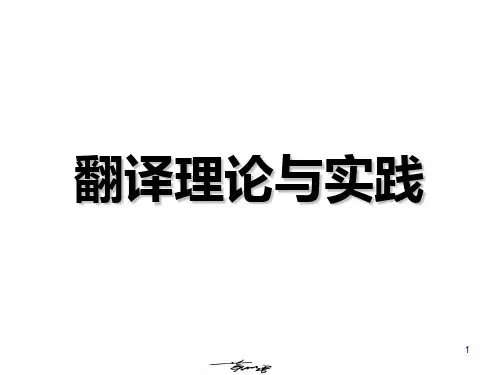
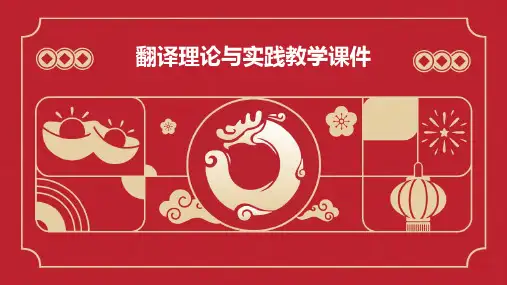
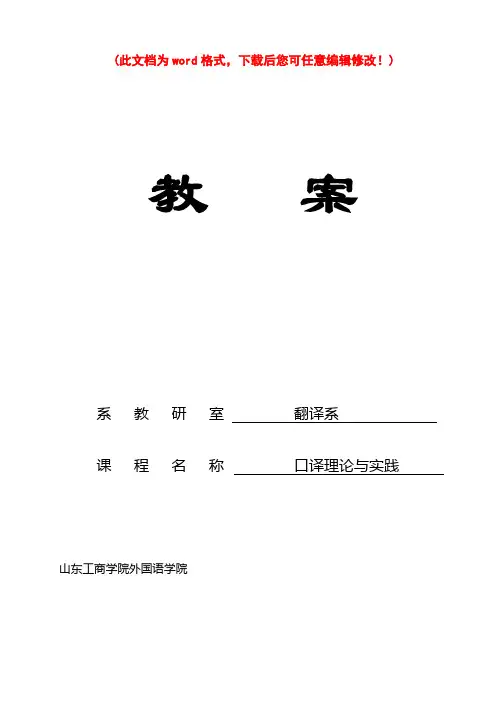
(此文档为word格式,下载后您可任意编辑修改!)教案系教研室翻译系课程名称口译理论与实践山东工商学院外国语学院【首页】课程类型必修课院级公共课();基础或专业基础课();专业课(√)选修课限选课();任选课()授课方式课堂讲授(√);实践课()考核方式考试(√);考查()课程教学总学时数32学时分配课堂讲授 32 学时;实践课学时教材名称《中级口译教程》第四版出版社及作者上海外语教育出版社梅德明编著指定参考书作者出版社出版时间1.《高级汉英口译教程》2.《实战口译》3. 《汉英口译入门》4. 《商务口译教材》5.《新编经贸口译教程》王逢鑫林超伦李长栓梅德明王学文外文出版社外语教学与研究外语教学与研究人民教育出版社中国对外经济贸易出版社2004版20042000版2004版2004版课程名称:口译理论与实践章节名称第一讲口译基础知识授课方式理论课(1);实践课(1);实习()教学时数2教学目的及要求1.掌握口译相关理论基础知识2.了解口译历史发展、定义、特点、标准、过程、类型、模式3.了解理论研究现状教学重点与难点口译的分类、标准和学习方法教学手段课堂讲授与学生实践相结合教学主要内容时间分配一.引言二.主要内容1、掌握口译相关理论基础知识口译历史发展、定义、特点、标准、过程、类型、模式、理论研究现状2、译员的素质和训练(思想品德、心理素质、语言、知识结构、健康体魄等)3、口译课程学习要求、自主学习方法讲解以及口译各类考试介绍4、口译技巧(一)听辨(范例分析与集体实练相结合)5、自主学习(一)口译小组安排、计划、听辨训练三.布置作业和思考问题课时分配:1、2 约为1.25 课时, 3、4 为0.75 课时,5 为课后1 小时复习思考题 1. 阅读课本第一部分口译概论2. 思考题:衡量口译的标准是什么?教学后记本章课堂教学讨论口译的基本概念和做好一名口译员的基本要求。
教学过程中采用任务型教学法,通过设问、启发、讨论等互动方式,鼓励学生主动参与学习。
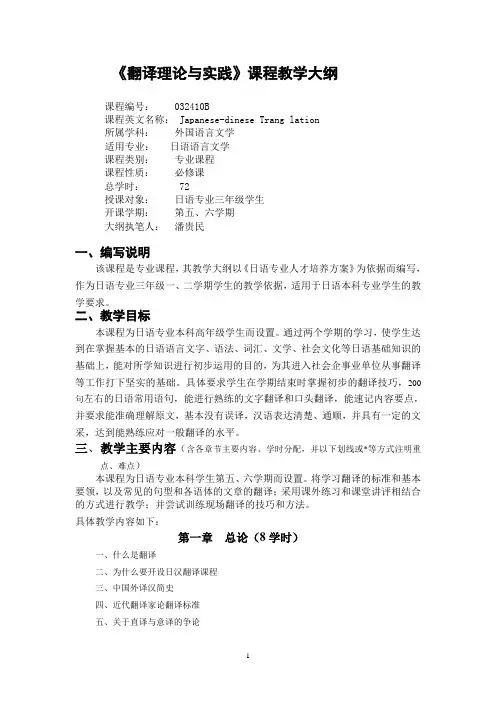
《翻译理论与实践》课程教学大纲课程编号: 032410B课程英文名称: Japanese-dinese Trang lation所属学科:外国语言文学适用专业:日语语言文学课程类别:专业课程课程性质:必修课总学时: 72授课对象:日语专业三年级学生开课学期:第五、六学期大纲执笔人:潘贵民一、编写说明该课程是专业课程,其教学大纲以《日语专业人才培养方案》为依据而编写,作为日语专业三年级一、二学期学生的教学依据,适用于日语本科专业学生的教学要求。
二、教学目标本课程为日语专业本科高年级学生而设置。
通过两个学期的学习,使学生达到在掌握基本的日语语言文字、语法、词汇、文学、社会文化等日语基础知识的基础上,能对所学知识进行初步运用的目的,为其进入社会企事业单位从事翻译等工作打下坚实的基础。
具体要求学生在学期结束时掌握初步的翻译技巧,200句左右的日语常用语句,能进行熟练的文字翻译和口头翻译,能速记内容要点,并要求能准确理解原文,基本没有误译,汉语表达清楚、通顺,并具有一定的文采,达到能熟练应对一般翻译的水平。
三、教学主要内容(含各章节主要内容、学时分配,并以下划线或*等方式注明重点、难点)本课程为日语专业本科学生第五、六学期而设置。
将学习翻译的标准和基本要领,以及常见的句型和各语体的文章的翻译;采用课外练习和课堂讲评相结合的方式进行教学;并尝试训练现场翻译的技巧和方法。
具体教学内容如下:第一章总论(8学时)一、什么是翻译二、为什么要开设日汉翻译课程三、中国外译汉简史四、近代翻译家论翻译标准五、关于直译与意译的争论六、如何学好日译汉及初学者常犯的毛病(一)不断提高日语水平——理解方面常见错误(二)提高中文水平(三)善于使用工具书七、翻译文章的具体步骤第二章句子的译法(14学时)第一节移位法——单句的翻译(一)主语的移位(二)客语的移位(三)用修——补语的移位第二节拆句法——复句的翻译(一)长连体修饰句的拆译(二)长连用修饰句的译法(三)长并列句及复杂句的译法第三节加译与减译(一)加译(二)减译第四节改变成分法第五节合并句子法第六节语言凝练法(浓缩法)1、目的2、什么是凝练法3、如何凝练第三章词的译法(14学时)第一节翻译中修辞的必要性第二节选词的方法(一)注意上下文的逻辑关系(二)注意作者的立场(三)选词要符合环境、气氛(四)选词应注意文章体裁(五)注意语言的时代性第三节词语的具体化与概括化第四节词语的反译法第五节把握中文词的含义第四章文章的翻译(30学时)一、贸易信函的翻译二、贸易信函翻译练习三、报刊文章的翻译四、论说文的翻译1、注意事项2、论说文选(一)科学者と頭(二)国際環境と日本五、随笔的翻译1、注意事项2、随笔文选(一)光陰矢の如し(二)こわい先生たち(三)北の森から(四)沈黙の世界(五)河豚(六)おふくろ(七)人生は変幻の猫(八)おそれという感情六、小说的翻译(一)青い壶(二)絵本(三)転落の詩集第五章练习题参考答案及译文(2学时)五、教材(名称、作者、出版社、出版时间)《新编日汉翻译教程》,庞春兰编著,北京大学出版社,1998年3月。
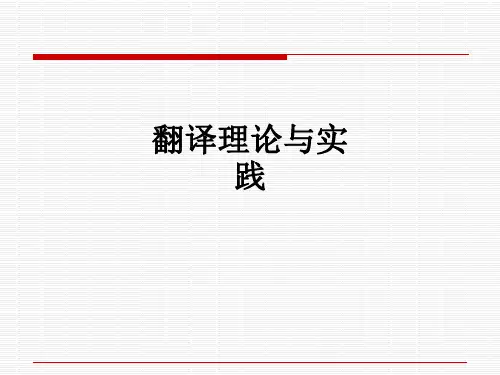

第一章英汉文化对比与翻译有一则趣谈:一所国际公寓闹火灾,里面住有犹太人,法国人,美国人和中国人.犹太人急急忙忙先搬出的是他的保险箱,法国人先拖出的是他的情人,美国人则先抱出他的妻子,而中国人则先背出的是他的老母.一、文化的定义文化是指人类社会历史实践过程中所创造的物质财富,精神财富和相应的创造才能的总和。
文化包括物质文化与精神文化,物质文化是指文化中看得见,摸得着的那部分,因此也称之为硬文化.相对来说,精神文化就是软文化,而软文化则是文化的深层结构。
美国著名翻译理论家尤金.奈达将语言文化特性分为五类:Ecological Culture 生态文化Material Culture物质文化Social Culture社会文化Religious Culture宗教文化Linguistic Culture语言文化二.中西方文化差异(一)西方重唯理,思辩,中方重经验,直觉(二)西方的细节分析与中方的整体综合(三)中西方价值观与人生追求的不同三、文化影响翻译的表现形式:(一)词汇空缺现象(Zero of equivalent word)在一种语言里的有些词在另一种语言里没有对等或契合的词,有人称这种情况为词汇空缺(lexical gap) Salad沙拉Lost Generation迷惘的一代Beat Generation垮掉的一代Baby Boomers生育高峰儿婴儿潮一代Y uppies雅皮士Dinks丁克Sandwich Generation三明治世代Couch Potato电视迷老泡在电视机前的人;终日懒散的人Mall Rats购物狂Hippie嬉皮士功夫kongfu叩头kowtow 炕Kang太极Taichi粽子Zongzi苦力Kuli饺子jiaozi 还有一些民族文化内涵特别丰富的词语,在翻译时也必须采用释义或注释等方法,说明该词的语用含义,才能使译语读者了解原语独特的文化现象。
如:钱先生周岁时“抓周”,抓了一本书,因此得名“钟书”。
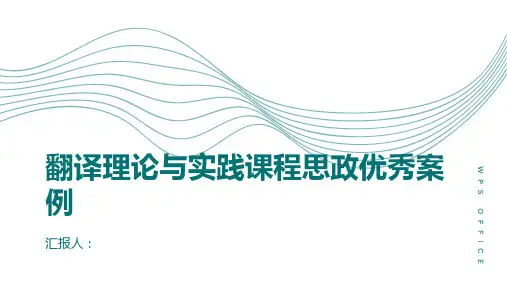
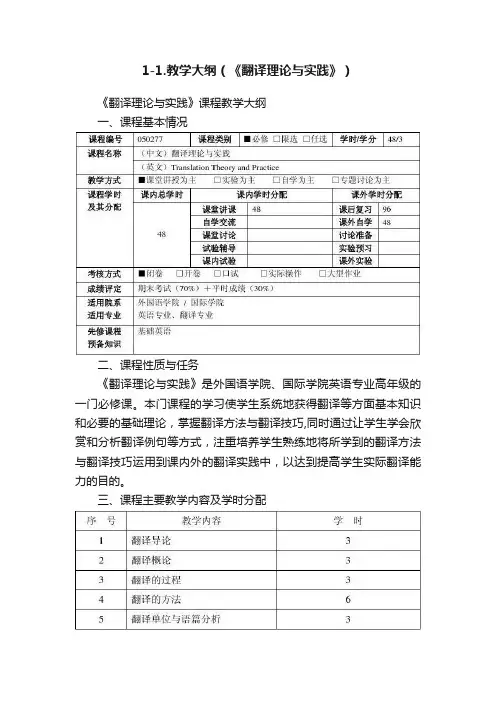
1-1.教学大纲(《翻译理论与实践》)《翻译理论与实践》课程教学大纲一、课程基本情况二、课程性质与任务《翻译理论与实践》是外国语学院、国际学院英语专业高年级的一门必修课。
本门课程的学习使学生系统地获得翻译等方面基本知识和必要的基础理论,掌握翻译方法与翻译技巧,同时通过让学生学会欣赏和分析翻译例句等方式,注重培养学生熟练地将所学到的翻译方法与翻译技巧运用到课内外的翻译实践中,以达到提高学生实际翻译能力的目的。
三、课程主要教学内容及学时分配四、课程教学基本内容和基本要求(一)翻译导论1. 提出为什么学翻译理论与实践、学什么、怎样学等方面的基本问题。
2. 课堂上与学生们共同探讨、分析这些问题等。
3. 目的是让学生对翻译理论与实践有一个初步的了解和认识,力图在问与答的过程中对学生在翻译方面产生启迪的作用。
(二)翻译概论1. 翻译的定义:理解翻译的定义,在比较中外的翻译定义中,认识翻译定义的内涵,确定并熟记相对正确的翻译定义。
2. 翻译的标准:掌握古今中外针对不同文体或内容的翻译标准,正确认识当今中国通用的翻译标准,并要求学生能用不同的翻译标准指导日后不同类型的翻译实践。
(三)翻译的过程1. 翻译的理解:首先了解翻译理解阶段之前的粗读、细读和通读三个层次的阅读;其次了解翻译理解阶段中的语言分析、语境分析和逻辑分析。
2. 翻译的表达:掌握在翻译的表达阶段需要处理的三种关系:忠实与通顺的关系、内容与形式的关系以及克己与创造的关系。
3. 翻译的审校:了解翻译最后阶段的“三校”:1)对照原文校对,侧重漏译、误译等;2)脱离原文审校,侧重生硬、拗口等;3)朗读译文审校,侧重流畅、自如等。
(四)翻译的方法1. 异化法:首先,弄清翻译理论家对直译和意译的不同看法;其次,明白异化法与归化法是直译与意译的延伸却不完全等同;最后,懂得直译和意译局限于语言层面的价值取向,异化和归化则是立足于文化大语境的价值取向;通过罗列中外翻译史上异化法和归化法之间的搏弈,学生懂得搏弈结果是异化译法占下风,而归化译法占上风,可尽管如此,从翻译的角度来看,还是强调异化为翻译主要方法,并知道强调的四大理由。
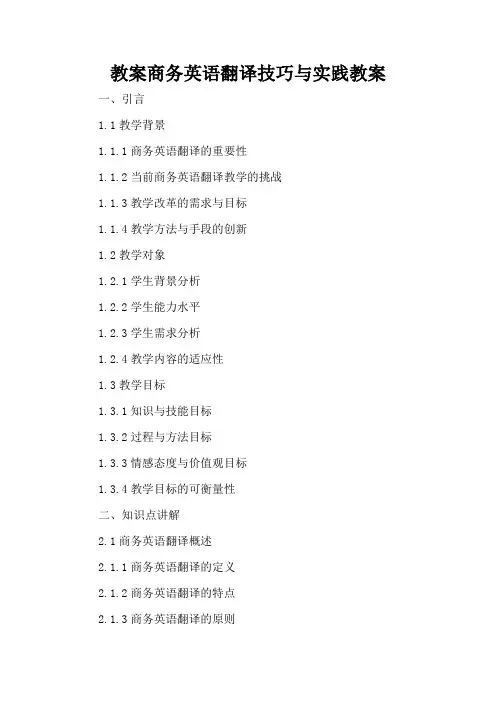
教案商务英语翻译技巧与实践教案一、引言1.1教学背景1.1.1商务英语翻译的重要性1.1.2当前商务英语翻译教学的挑战1.1.3教学改革的需求与目标1.1.4教学方法与手段的创新1.2教学对象1.2.1学生背景分析1.2.2学生能力水平1.2.3学生需求分析1.2.4教学内容的适应性1.3教学目标1.3.1知识与技能目标1.3.2过程与方法目标1.3.3情感态度与价值观目标1.3.4教学目标的可衡量性二、知识点讲解2.1商务英语翻译概述2.1.1商务英语翻译的定义2.1.2商务英语翻译的特点2.1.3商务英语翻译的原则2.1.4商务英语翻译的方法2.2商务英语翻译技巧2.2.1词汇翻译技巧2.2.2句子翻译技巧2.2.3文本翻译技巧2.2.4文化差异的处理2.3商务英语翻译实践2.3.1实践活动的目的与意义2.3.2实践活动的组织与实施2.3.3实践活动的评价与反馈2.3.4实践活动与理论教学的结合三、教学内容3.1商务英语翻译理论知识3.1.1商务英语翻译的基本概念3.1.2商务英语翻译的常用术语3.1.3商务英语翻译的基本原则3.1.4商务英语翻译的基本方法3.2商务英语翻译实践技能3.2.1词汇翻译技能3.2.2句子翻译技能3.2.3文本翻译技能3.2.4文化差异的处理技能3.3商务英语翻译实践案例分析3.3.1案例分析的目的与意义3.3.2案例分析的组织与实施3.3.3案例分析的评价与反馈3.3.4案例分析与理论教学的结合四、教学目标4.1知识与技能目标4.1.1掌握商务英语翻译的基本概念和常用术语4.1.2学会商务英语翻译的基本原则和方法4.1.3提高商务英语翻译的实践技能4.1.4培养学生的跨文化交际能力4.2过程与方法目标4.2.1通过课堂讲解和案例分析,培养学生的商务英语翻译能力4.2.2通过实践活动,提高学生的商务英语翻译实践技能4.2.3通过小组讨论和互动,培养学生的合作能力和批判性思维能力4.2.4通过评价与反馈,提高学生的自我反思和自我提升能力4.3情感态度与价值观目标4.3.1培养学生对商务英语翻译的兴趣和热情4.3.2培养学生的跨文化意识和国际视野4.3.3培养学生的职业道德和职业素养4.3.4培养学生的自主学习能力和终身学习意识五、教学难点与重点5.1教学难点5.1.1商务英语翻译的基本原则和方法5.1.2商务英语翻译实践技能的培养5.1.3文化差异的处理5.1.4学生的跨文化交际能力的培养5.2教学重点5.2.1商务英语翻译的基本概念和常用术语5.2.2商务英语翻译实践案例分析5.2.3学生的商务英语翻译实践技能的提高5.2.4学生的自主学习能力和终身学习意识的培养六、教具与学具准备6.1教具准备6.1.1多媒体设备6.1.2教学课件6.1.3教学案例材料6.1.4教学辅助资料6.2学具准备6.2.1笔记本和文具6.2.2商务英语翻译教材6.2.3商务英语翻译实践材料6.2.4翻译软件和在线资源七、教学过程7.1导入新课7.1.1引入商务英语翻译的话题7.1.2激发学生的学习兴趣和动机7.1.3明确教学目标和要求7.2课堂讲解7.2.1讲解商务英语翻译的基本概念和常用术语7.2.2讲解商务英语翻译的基本原则和方法7.2.3讲解商务英语翻译实践技能的培养7.2.4讲解文化差异的处理7.3案例分析7.3.1分析商务英语翻译实践案例7.3.2引导学生参与案例讨论和互动7.3.3提供案例分析和评价的标准八、板书设计8.1教学内容的梳理8.1.1商务英语翻译的基本概念和常用术语8.1.2商务英语翻译的基本原则和方法8.1.3商务英语翻译实践技能的培养8.1.4文化差异的处理8.2教学重点与难点的强调8.2.1商务英语翻译的基本原则和方法8.2.2商务英语翻译实践技能的培养8.2.3文化差异的处理8.2.4学生的跨文化交际能力的培养8.3教学案例的展示与分析8.3.1商务英语翻译实践案例的展示8.3.2案例分析的步骤和方法8.3.3案例评价的标准和依据九、作业设计9.1课后练习题9.1.1商务英语翻译基本概念和常用术语的练习9.1.2商务英语翻译基本原则和方法的练习9.1.3商务英语翻译实践技能的练习9.1.4文化差异处理能力的练习9.2案例分析报告9.2.1选择商务英语翻译实践案例进行分析9.2.3案例分析报告的评价标准9.2.4案例分析报告的提交和反馈9.3自主学习任务9.3.1自主学习商务英语翻译相关资料9.3.3自主学习成果的评价和反馈9.3.4自主学习成果的分享和交流十、课后反思及拓展延伸10.1教学反思10.1.1反思教学过程中的优点和不足10.1.2反思教学目标是否达成10.1.3反思教学方法和手段的有效性10.1.4反思学生的参与度和学习效果10.2拓展延伸10.2.1提供商务英语翻译相关的拓展阅读材料10.2.2安排商务英语翻译相关的实践活动10.2.3鼓励学生参与商务英语翻译相关的竞赛和项目10.2.4提供商务英语翻译相关的培训和进修机会重点和难点解析一、重点关注环节1.教学内容的梳理2.教学重点与难点的强调3.教学案例的展示与分析4.课后练习题和案例分析报告5.教学反思和拓展延伸二、详细补充和说明1.教学内容的梳理在教学内容的梳理环节中,需要重点关注商务英语翻译的基本概念和常用术语的讲解,以及商务英语翻译的基本原则和方法的应用。


硕士研究生课程教学大纲《翻译理论与实践》(英文名称:Translation Theory and Practice)一、课程说明1、课程编码:0130502052052、学分: 2 学时:343、课程类别:专业学位课4、开课学院:翻译学院5、课程简介:本课程是一门日语语言文学专业专业学位课,是学生学习、了解和掌握基本翻译概论和基本翻译技巧及翻译策略的入门课程。
本课程的主要任务是使学生从国内外基本翻译观点、基本翻译简史、基本翻译技巧的一般规律和原则出发,配合以实际的各种日汉语文本翻译实例,在理论和实践互相结合的基础上,掌握日汉互译理论与技巧的基本特点、主要内容、实际应用策略,使学生把握日汉互译理论与技巧的基本内容、特征及日译中和中译日的异同点。
6、预备知识:需要本科学习阶段的商务翻译、高级日语、中级日语、日汉互译基础、基础笔译等基础课程的知识准备为预备知识。
7、教学目的与要求:1)教学目的:1.了解日汉互译理论的基本特征和日译中、中译日的异同点所在;2.把握日汉互译的基本策略和代表性的日汉互译理论、观点及常用技巧;3.把握国外翻译理论对中国翻译理论的影响、启示和比较4.掌握中译日和日译中的具体翻译技巧在不同文本翻译方面的异同点。
5.了解不同翻译理论流派的基本观点及其对日汉互译的影响和应用。
6.达到一定的笔译速度,且行文流畅、意思通达、表述自然。
2)教学要求A.翻译理论方面(1)基本了解中西方翻译理论发展的几个阶段及主要代表性观点(2)基本掌握中西方主要翻译流派的名称、观点及代表人物(3)基本掌握中西方各主要翻译理论流派的主要观点及其在日汉互译中的应用(4)掌握日汉互译中所涉及到的翻译理论及翻译策略(5)必须掌握日汉互译中所遵循的一般规律及基本原则(6)掌握翻译理论研究论文的选题、写作及研究趋势B.翻译技巧方面(1)基本了解日汉互译中所遵循的归化、异化等一般常用规律、策略及基本技巧(2)掌握日汉互译中增译、减译、直译、意译、倒译、顺译等具体的翻译策略(3)掌握不同日汉语文本主要采用的不同翻译策略及技巧(4)掌握日译汉中的省略现象、长句翻译等特殊翻译技巧(5)掌握汉译中特有专业词汇、专业文本的翻译要点(6)掌握翻译方法研究论文的写作特点C翻译能力方面(1)掌握日汉语基本语言特点、语法规律、文本格式(2)掌握日汉语中基本常用句型的翻译要点及翻译手法(3)掌握常用日汉语文本的阅读技巧、阅读速度及日汉互译时的注意事项(4)能够正确借用电子词典、网络等辅助工具进行一定文本的翻译(5)掌握中日经济、文化、科技等一般常用词汇的互译(6)掌握日汉语常用翻译技巧和翻译现象研究论文的写作技巧8、考核方法与要求:考核方法:①期末闭卷考试②期末闭卷考试与学期末论文相结合的方式组成及占分比例:①期末考试成绩100分②期末闭卷成绩(100分)+期末学论文(分)=总成绩9、教材与参考书:教材:1.李文革《西方翻译理论流派研究》,中国社会科学出版社,2004版。
教师教案课程名称:英语翻译理论与实践1英文名称:Translation Theories and Practice 1课程编号:课程类别:专业基础课学分:2总学时:32理论学时:32实验学时:0授课班级:使用教材:英汉互译实践与技巧(第三版)任课教师:职称:所在单位:院系(部处)系教务处制教案填写说明教案按每一大节课进行编写,其进度应与授课计划相同。
教案可以是打印稿也可以是手写稿。
有关部分填写要求如下:1、课程类别(封面):包括公共课、学科基础课、专业基础课、专业方向课、实践性教学环节、实验课、专业任选课、公选课。
2、课堂教学目的及要求:本大节课(本次课)的教学目的及要求。
3、课堂教学重点及难点:指根据教学大纲要求,确定课堂教学知识信息的重点、难点。
4、教学过程:这是整个教案的主体部分,既体现出教学活动的逻辑程序,又要划分出若干环节或步骤,并考虑到它们的时间分配、具体方法的应用,相互间的衔接、过渡,以及教学过程与板书的协调等等,充分反映教师教学设计思想,体现教师的教学经验和风格。
5、教学方法及手段:指举例讲解、多媒体讲解、模型讲解、实物讲解、挂图讲解、音像讲解等。
6、课后作业与思考题:指本大节课(本次课)结束后需要布置的作业与思考题。
7、课后小结:课后自我总结分析是对课程教学中教学环节的设计、教学重点难点的把握、教学方法的应用、师生双边活动的设计及教学效果等情况的总结与分析,为以后的教学提供经验与参考。
第1次课2学时教师教案注:每项页面大小可根据实际情况自行添减Teaching Notes—— A Brief Introduction to Translation翻译概论作为第一讲,有必要向学生简要全面介绍一下教材的内容和特点、该课程的具体要求以及学习方法。
《英汉互译实践与技巧》是清华大学优秀教材,该教材内容丰富、新颖,具有很高的权威性。
编者许建平现为清华大学外语系教授、硕士研究生导师,在翻译理论和实践方面造诣很深,在国内翻译界具有很高的威望。
翻译理论与实践电子教案专业名称:商务英语专业课程名称:《翻译理论与实践》主导教材:冯庆华《实用翻译教程》(英汉互译) 所属教研室:英语专业教研室任课教师:适用年级:商务英语专业本科三年级Teaching Plan for Translation (1)#Title of Lesson: A Brief Introduction to TranslationWeek 1#Time Needed:Two periods(40 minutes per period)#Teaching Objectives:1.Help the students achieve a basic understanding of translation: its nature, classification, evaluation criteria, the role of translator, etc.2.Briefly introduce to the students the development of translation in China.#Key Teaching Points:1.The nature and evaluation criteria of translation.2.The difficulties involved in translating process.#Teaching Contents:I.Discussion:●What is translation?●What is a successful translation?●What difficulties might occur in translating process?A.What is translation?1.Key words:source language(SL) / receptor language / target language(TL);reproduce; message / information; equivalence / correspondence2.Nature of translation (Eugene A. Nida):Translation consists in reproducing in the receptor language theclosest natural equivalent of the source language message, first in termsof meaning and secondly in terms of style.3.Classification of translation:a.Oral interpretation / written translationb.Human translation / machine translationc.Literary / scientific / political / commercial translationd.Domestication (naturalization) / foreignization (estrangement,alienation)e.Literal translation / free translationB.What is a successful translation?1.严复:信、达、雅(faithfulness, expressiveness, elegance)2.傅雷:以效果而论,翻译应当象临画一样,所求的不在形似而在神似3.钱钟书:诱、讹、化4.Eugene A. Nida: natural / close; dynamic/functional equivalenceC.What difficulties might occur in translating process?nguage / Cultural BarriersTranslatability is lower when (1) the work to be translated is quitedistant both in time and space; (2) its form is very much unique; (3) thecontent is not shared in the two cultures.→ Betrayal: Loss / Distortion2.Example analysis:a.东边日出西边雨,道是无晴.却有晴.。
b.纵一苇..之所如,凌万顷之茫然c.The whole sky spangled gay twinkling stars, and the Milky Way is asdistinct as though it had been washed and rubbed with snow forholiday.——整个天空点缀着繁星,快活地眨着眼。
天河..那么清楚地显现出来,就好像有人在过节以前用雪把它擦洗过似的.........。
d.He made you a highway to my bed;But I, a maid, die maiden-widowed.—Romeo and Juliet译文1:他要借你做牵引相思的桥梁可是我却要做一个独守空闺的怨女而死去。
译文2:他本要借你做捷径,登上我的床;可怜我这处女,活守寡,到死是处女。
3.In the long run there is a tendency: translation itself can convertintranslatability into translatability.e.g. crocodile‘s tears; science / democracyII.The Role of Translator:The craft of translator is … deeply ambivalent; it is exercised in a radical tension between impulses to facsimile and impulses to appropriate recreation.— George Steiner 译者的技艺是一个深刻的矛盾体。
这种技艺是在两种冲动的极度张力之间形成的:一方面是依样画葫芦的冲动,另一方面又有适当再创作的冲动。
A.Metaphors for translator:1. A courier of the human spirits (普希金)2. A sculptor who tries to recreate a work of painting3. A straitjacketed dancer4. A musician / an actor5.Traduttori-traditori (Translators are traitors.)B.Responsibility of translator:petent linguistic ability & bicultural knowledge2.Being as transparent as possible3.Being a good negotiatorIII.The Development of Translation in China:翻译史上的三个高峰期:1.汉至唐宋佛经的转译:支谦;鸠摩罗什;道安;玄奘2.明清以后西欧科技文化的引进:徐光启;严复;林纾;(译才并世数严林-康有为)3.五四之后的现代阶段:郭沫若;鲁迅;瞿秋白;傅雷;钱钟书IV.Homework:People will be amazed by her stunning beauty at the first sight. Simple as she is, nature endows her with an inherent attractiveness, which is polished and brought out by sophisticated modern technology and superlative craftsmanship. In this way, innovation sustains the nature's art of creation while ingenuity whets people's desire.Reference translation:她的美,令人一见惊艳。
她原本生来资质俏丽,再加上现代科技的修饰及极品手艺的打造。
如此一来,她既有天生的美感,又有人工的魅惑。
#Title of Lesson: Contrast between English and Chinese (1)Week 2#Time Needed:Two periods(40 minutes per period)#Teaching objectives:1.Introduce to the students some basic differences between English and Chinese. 2.Briefly analyze the influence of these differences on translating.#Key Teaching Points:The difference of language embodies the difference in thinking styles.#Difficult Teaching Points:The embodiment of different syntactic features in translating process#Teaching Contents:I.Thinking Style and DictionA.Insubstantial(虚)vs. Substantial(实)1.Embodimente.g. In this new year, we face momentous uncertainties: war (or wars), aweak economy.译:这新的一年里,我们面临着战争(乃至连续的...战争)、经济低迷等一系列..。
...重大的不确定因素2.Visualizatione.g. utterly quiet鸦雀无声e.g. In 1966 the North Korean team made it to the quarter finals.译:1966年,北朝鲜队成功地踢进..了四分之一决赛。